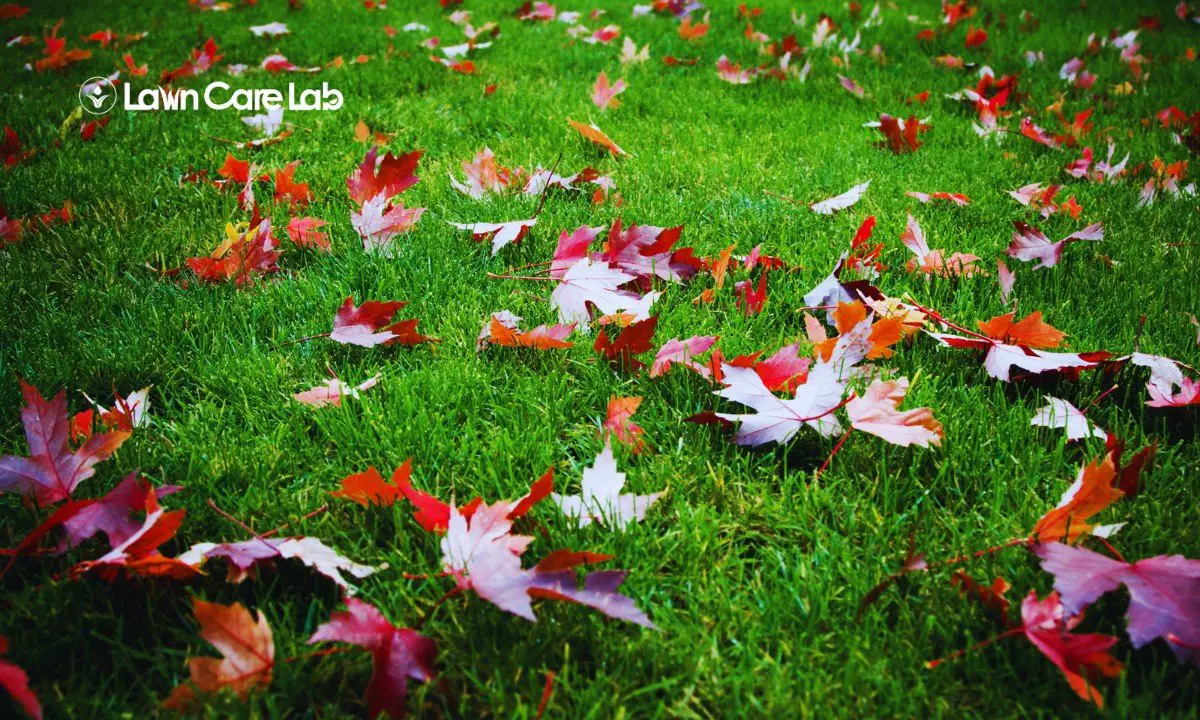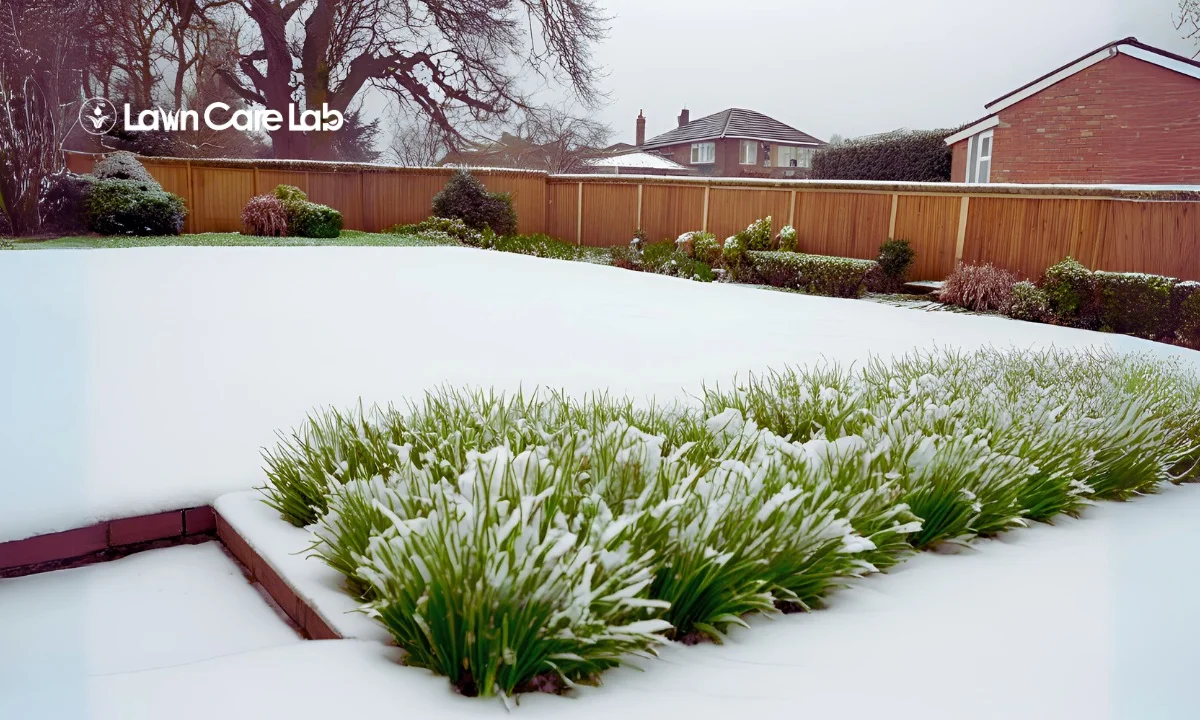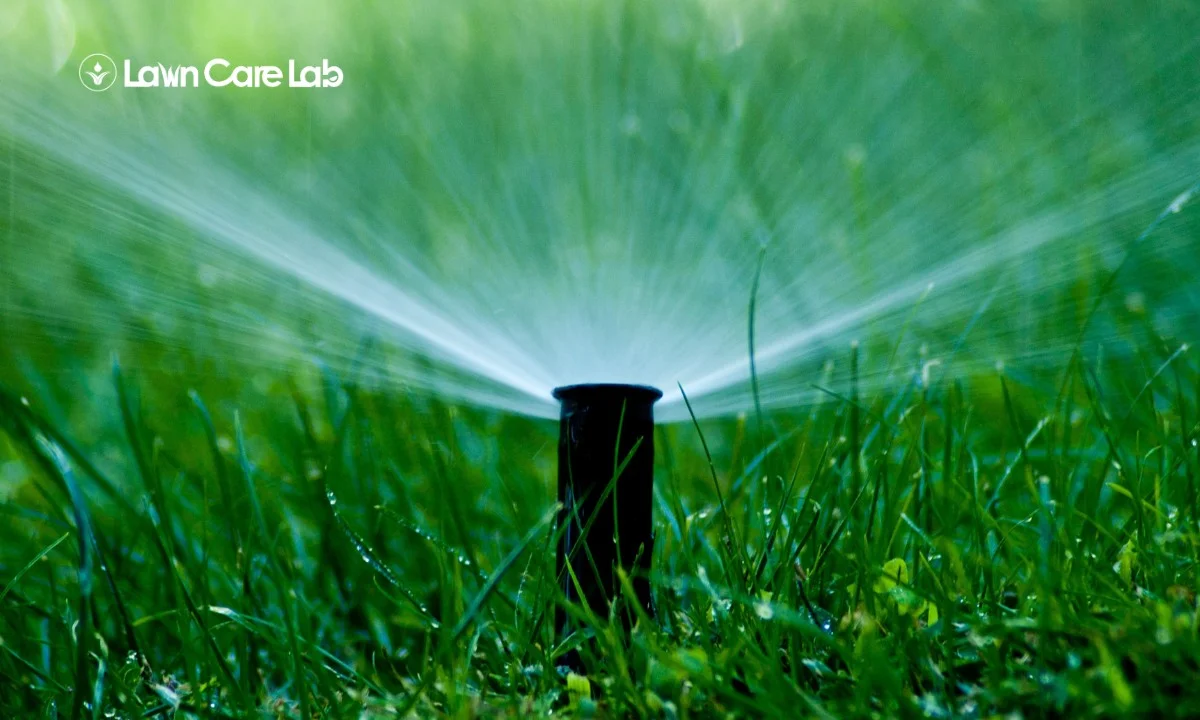Indeed, as the renowned poet Robert Frost once penned, ‘Nothing gold can stay,’ and sadly, this includes your lush summer lawn.
However, with our expert guidance and six critical steps, you can protect your lawn during winter.
From the right timing for your last mow to the correct way to mulch, we’ll guide you to maintain your lawn‘s health.
So, get your rake at the ready and don your gardening gloves – it’s time to get Fall lawn prep.
Table of Contents
Continue Mowing Into Fall, Gradually Raising Height
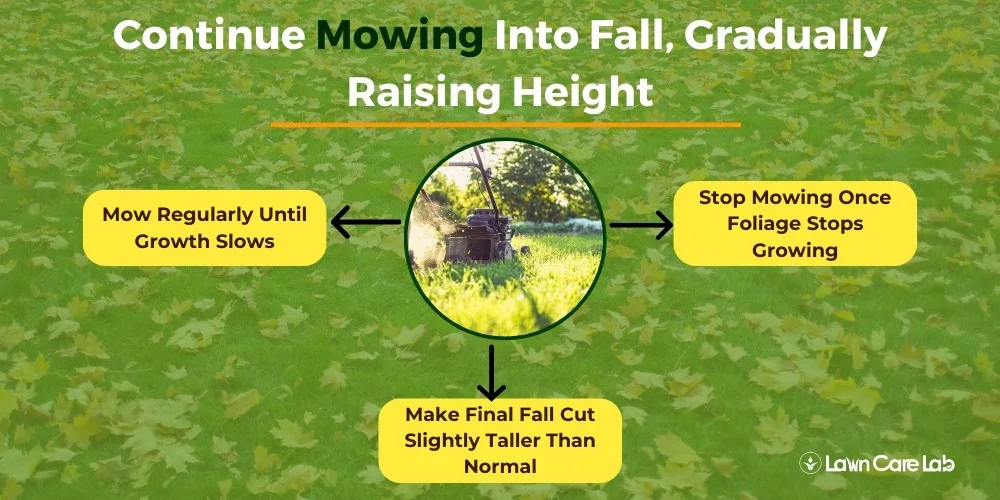
Adjust your mowing schedule in the fall as the lawn growth slows down. Raise your mower’s cutting height slightly before winter for a taller cut during the last few mows.
Give your mower a break when the grass stops growing until winter‘s end.
Mow Regularly Until Growth Slows
Regular mowing keeps your lawn healthy and visually appealing.
However, to make the most out of your mowing, you need to consider several important factors:
Blade sharpness: Your lawn’s health depends on the sharpness of your mower’s blade. Clean cuts reduce stress on the grass.
Mowing patterns: Switching up your mowing pattern is important to prevent soil compaction, which can damage your grass.
Equipment maintenance: Regular mower maintenance improves efficiency and lifespan.
Climate considerations: Monitor the weather’s impact on grass growth and mowing frequency.
Keep your lawn healthy by giving it consistent, informed care. Continue mowing until the growth rate slows down.
Make Final Fall Cut Slightly Taller Than Normal
Raise the mower’s cutting height in autumn for taller grass on the final cut. This promotes growth, aids lawn survival in colder months, and reduces pest and disease risks.
Different grass types require different mowing heights. In fall, a taller cut can protect your lawn from pests and diseases during winter.
In addition, Your lawn’s health depends on proper equipment maintenance. A well-maintained mower delivers clean, sharp cuts, reducing the risk of damage and disease.
Stop Mowing Once Foliage Stops Growing
Keep your lawn clean even after the vegetation stops growing. Sunlight is crucial for the grass’ health.
Consider mulching leaves instead of disposing of them to enrich the soil and retain water.
Consider these practical tips:
- Opt for grass types that are well-suited to your local climate.
- Be vigilant and routinely inspect your lawn for any pest infestation.
- To prevent snow mold, refrain from accumulating snow on your lawn.
- Maintain your gardening tools to prepare for the following lawn care season.
- Utilize a mulching mower to finely chop leaves, then distribute them evenly across your lawn.
Adopting these habits will help your lawn weather the winter and guarantee its glorious return when spring arrives.
Aerate Compacted Areas to Improve Winter Drainage
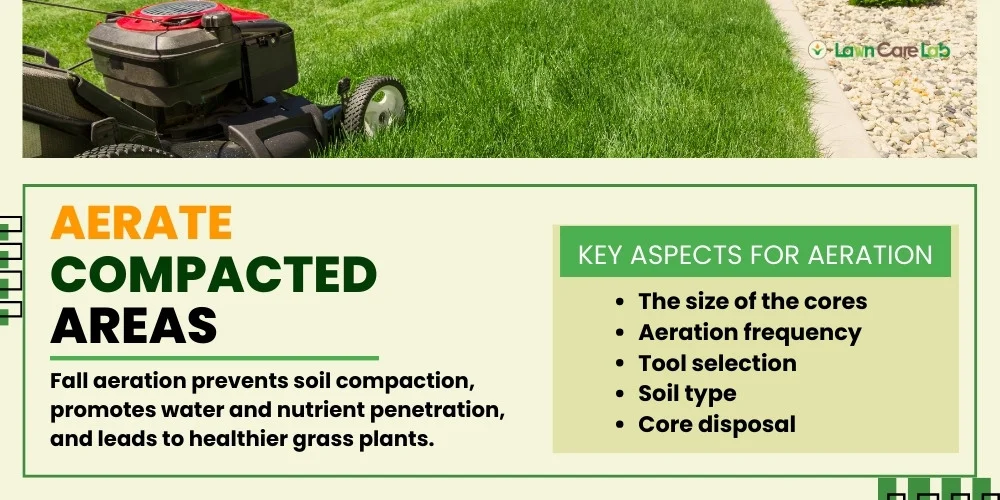
Fall aeration prevents soil compaction, promotes water and nutrient penetration, and leads to healthier grass plants.
Core aeration alleviates soil compaction by letting air and water access the roots more efficiently.
Aerate your lawn six weeks before the first frost for best results.
Use Core Aeration to Relieve Soil Compaction as fall lawn prep
Core aeration combats lawn soil compaction. It’s essential for vibrant green spaces.
Five key aspects you need to focus on:
- The size of the cores: Bigger is often better. Larger cores tend to alleviate compaction more effectively.
- Aeration frequency: If your soil is heavily compacted, you might need to aerate it more frequently.
- Tool selection: The type of soil determines the most suitable tool. Choose wisely for the best outcome.
- Soil type: Clay-based soils are prone to compaction and may require aeration more frequently.
- Core disposal: Leave cores on the lawn to enrich the soil naturally.
Pull Plugs to Allow Air and Water to Reach Roots
Improve your lawn’s health with plug pulling. Let air and water reach the roots by removing small plugs of soil. Use the right size and depth for minimal disruption to the grass.
| Optimal Depth | Ideal Plug Size | Root Health Check Frequency |
|---|---|---|
| Deep | Small | Constant Vigilance |
| Medium | Medium | Routine Checks |
| Shallow | Large | Periodic Observations |
| Very Deep | Very Small | Uninterrupted Monitoring |
| Very Shallow | Very Large | Infrequent Examination |
After removing the plug, consider eco-friendly disposal methods. Monitoring root health is key to evaluating aeration success. Empower your lawn care and watch your grass thrive.
Time Aeration Approximately 6 Weeks Before First Frost
Aerate your lawn six weeks before the first frost for better winter drainage and protection.
Fall soil temps boost root growth. Aeration helps grass prep for winter by reducing compaction and thatch and improving nutrient intake. Timing is key.
Aeration is more than just punching holes in your lawn. Consider it as a rejuvenating therapy for your lawn’s health.
Overseed Bare Patches to Limit Spring Weed Growth
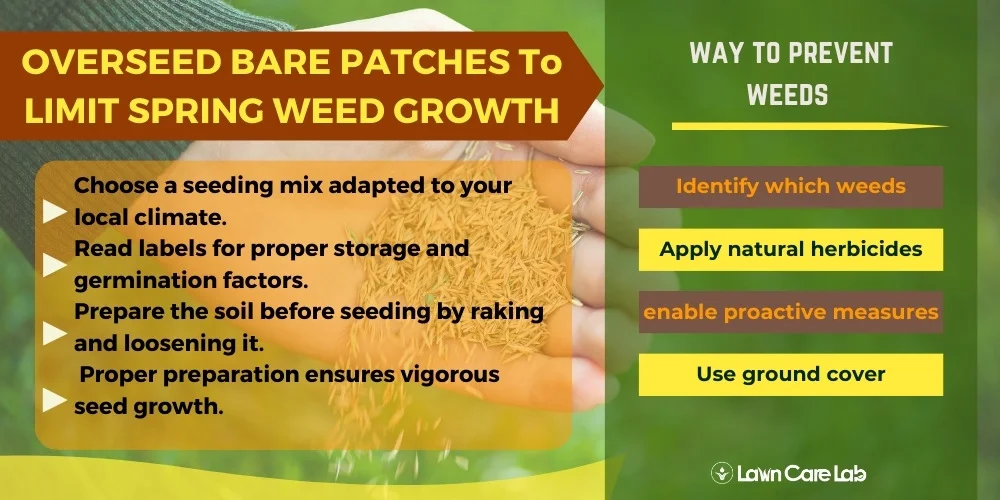
To keep those pesky spring weeds at bay, one effective strategy is to overseed any bare patches in your lawn.
The first step is to grab a rake and gently break up the soil, readying it to introduce new grass seeds.
Choosing the right seed blend is crucial here. You must select a variety that suits your particular weather conditions and regional climate for the best results.
Repair Thin Areas Prone to Weed Encroachment
Maintaining a green lawn is tough, especially with weed encroachment. Identify the type of weed and its growth pattern to prevent an invasion.
Here’s a natural, eco-friendly approach to fortifying your lawn against weed encroachment:
- Identify which weeds are present in the lawn.
- Apply natural herbicides once weeds are recognized for effective, eco-friendly prevention.
- Study weeds’ growth cycles to enable proactive measures before encroachment.
- Use ground covers in thinning areas to occupy space, preventing weed growth.
As you implement these steps, remember to prepare your soil adequately. This includes raking and loosening the soil before you sow any grass seeds.
Rake and Loosen Soil Before Applying Grass Seed
Loosen soil before seeding to improve germination and prevent weeds.
| Key Steps for Successful Seeding | The Impact |
|---|---|
| Testing Soil pH | Helps gauge the soil’s suitability |
| Choosing the Right Grass Type | Guarantees a lush, vibrant lawn |
| Steps to Prevent Soil Erosion | Helps conserve the soil’s nutrient supply |
Select Seeding Mix Suited to Your Climate and Conditions
Choosing the right seeding mix is the first step toward a lush, resilient lawn. Opt for climate-adaptive seeds, particularly drought-resistant ones, to help your lawn flourish.
Here are a few essential pointers:
- Read seed labels. They provide crucial information about the seeds’ adaptability and needs.
- Pay attention to germination factors listed on the label, such as optimal temperature and light conditions.
- Store your seeds correctly. A cool, dry place is generally the best.
- Drought-resistant varieties should be your go-to choice if you live in an arid region.
- Remember your local climate and specific needs, and select seeds that adapt well to these conditions.
Fertilize Lightly to Support Root Growth Before Dormancy

Fertilize your lawn in the fall with a balanced, slow-release fertilizer using half the amount of nitrogen you’d use in spring or summer. This promotes healthy roots, not leafy growth. Use less fertilizer and let nature do the rest.
Choose Balanced Slow-Release Fertilizer for Fall Feeding
Opt for a slow-release fertilizer to feed your lawn this fall. The right balance of nutrients is crucial for a vibrant lawn. Organic options are cost-effective and better for soil health.
Take into account the following tips:
- Choose organic fertilizers for a greener approach to lawn care.
- Go for slow-release fertilizers to extend the duration of nutrient supply.
- Keep an eye on cost-effectiveness when selecting your fertilizer.
Apply Half the Nitrogen Used in Spring or Summer
To promote healthy root growth and prepare for winter, reduce nitrogen by half in autumn. Excessive nitrogen hinders nutrient uptake and turf health. This process lets your lawn grow naturally.
Target Root Production Over Foliar Growth with Fall Fertilizer
Prioritize root development over leaf growth in the fall.
Use less fertilizer to maintain the balance and direct nutrients toward root vitality:
- Organic fertilizers are a great choice due to their slow-release characteristics.
- A phosphorus-rich fertilizer is beneficial for promoting robust root health.
- Steer clear of fertilizers high in nitrogen as they stimulate leaf expansion.
- Utilize soil tests with pH levels to inform your fertilizer choice and application quantity.
Next, we’ll explore adapting watering practices to suit the chillier fall weather.
Adjust Watering for Cooler Fall Conditions
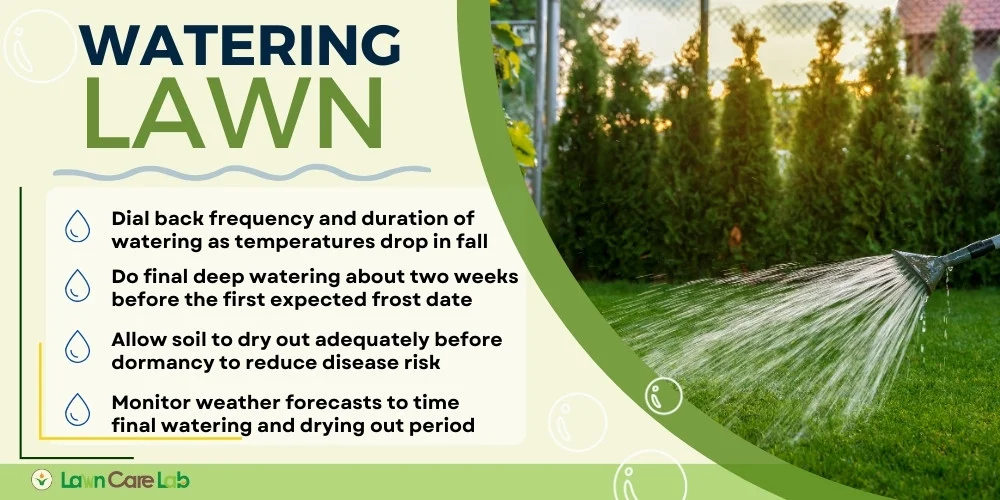
Adjust watering habits for fall. Water less frequently and for shorter periods. Water deeply two weeks before frost.
This ensures that the earth dries adequately before entering its dormant state, significantly reducing disease chances.
Gradually Dial Back The Frequency and Duration of Watering
Consider the following tips to maintain a robust lawn during the colder months:
- Opt for early morning watering sessions, as this minimizes the chance of evaporation.
- Water deeply, not frequently, to encourage deeper root growth.
- Frost can interfere with your lawn’s hydration process. If frost is forecasted, hold off on watering.
- Mulch can be a garden’s best friend. It helps limit evaporation and aids in moisture retention.
- Be vigilant for signs of winter dehydration in your lawn, like browning patches or wilting blades of grass.
Ultimately, the aim is to cultivate a resilient, well-hydrated lawn that will revive and flourish when spring arrives.
Perform Final Deep Watering Weeks Before First Frost
As winter approaches, give your lawn one last deep watering before pausing your watering routine until spring. This helps prep your lawn for the dry winter months and conserves water resources.
| Predicting frost | Timing is key. Use frost forecasts to plan your watering. |
| Preserving water | Keep tabs on your water usage to help conserve the environment. |
| Frost-friendly grass | Reduce winter lawn care by opting for grasses that can withstand the cold. |
| Scheduling irrigation | Strategically plan your watering for the best outcome. |
Let Soil Dry Out Before Dormancy to Prevent Disease
To enhance the success of your lawn maintenance efforts, here are some action items to consider:
- Conduct a soil test to uncover any nutrient shortfalls or imbalances.
- Adopt pest management measures to keep damaging insects and diseases at bay.
- Incorporate organic amendments to enrich the soil’s structure and fertility.
- Adjust watering schedules to encourage deep-root growth.
Ensuring your lawn remains dry in winter can lead to a lush landscape in spring.
Mulch Sensitive Areas Like Slopes and Tree Roots
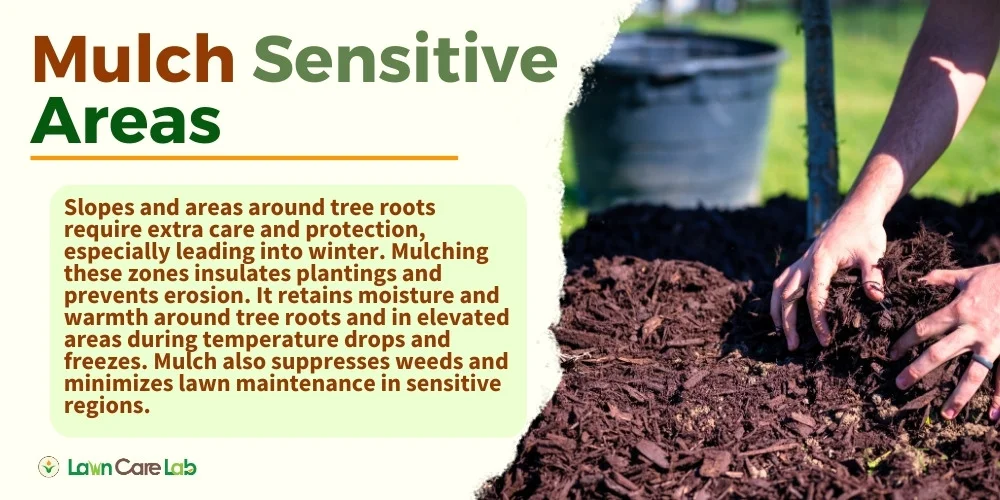
Mulching slopes and tree roots retain moisture and insulate against freezing temps.
Organic mulches such as wood chips or shredded leaves are fantastic options for this purpose.
Mulch Retains Moisture and Insulates Against Cold Snaps
Let me share some effective guidelines for winter mulching:
- Opt for organic mulches such as straw or shredded bark. They provide an excellent layer of insulation.
- If you have delicate perennials or newly planted trees, apply a thicker layer of mulch to protect them.
- Be cautious not to heap mulch against the trunks of trees or shrubs. This can cause damage over time.
- For expansive areas, mulch mats can be a practical solution.
- As mulch decomposes, it’s essential to replenish it regularly.
Avoid Over-Mulching Right Against Plant Crowns
Mulching is crucial for plant health but requires careful selection and application. Over-mulching can harm plant crowns, and sensitive areas like slopes and tree roots need gentle handling.
Let’s take a look at the different types of mulching materials, their application techniques, and their impact on plant health:
| Mulching Materials | Application Techniques | Impact on Plant Health |
|---|---|---|
| Organic Mulch | Layering | Boosts Soil Fertility |
| Inorganic Mulch | Spreading | Helps Retain Moisture |
| Recycled Mulch | Composting | Encourages Microbial Activity |
Organic mulches like wood chips or shredded leaves are eco-friendly and beneficial to your plants.
Use Organic Mulches Like Wood Chips or Shredded Leaves
Organic mulches, like wood chips and shredded leaves, protect slopes and tree roots from winter weather.
Here are some key points to remember when it comes to mulch application and composting:
- A layer of mulch approximately 3 inches thick is ideal for reaping maximum benefits.
- Composted organic mulch gradually releases nutrients, retains moisture, and lessens the need for regular watering.
- Use a garden fork or rake to spread mulch evenly across your garden.
Conclusion
Ready to safeguard your lawn for the winter months?
Continue mowing, aerate dense spots, and fill bare areas with additional seed.
Remember to lightly fertilize and adapt your watering schedule to align with the dropping temperatures.
Lastly, protect delicate spots with a layer of mulch.
These straightforward practices can ensure not just the survival but the flourishing of your lawn, priming it for a robust recovery come spring.
Isn’t that a worthwhile endeavor?
Frequently Asked Questions
What Type of Grass Seed Is Best for Overseeding in the Fall?”
How Can I Determine if My Lawn Needs Aeration?”
What Are Some Common Signs of an Overwatered Lawn in the Fall?”
What Kind of Mulch Is Most Effective for Protecting Slopes and Tree Roots?”
How Often Should I Fertilize My Lawn in the Fall to Support Root Growth?”
- How to Create a Lawn Care Schedule for Southern Climates - October 30, 2024
- How to Use Compost Tea to Boost Lawn Growth and Soil Health - October 23, 2024
- The Best Grasses for Saltwater-Exposed Lawns: Coastal Lawn Care - October 17, 2024

